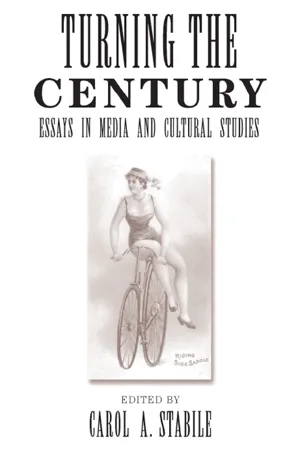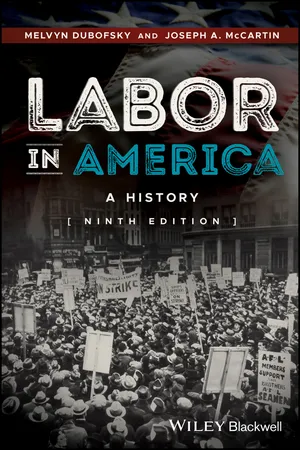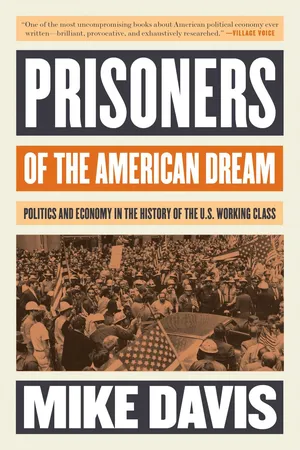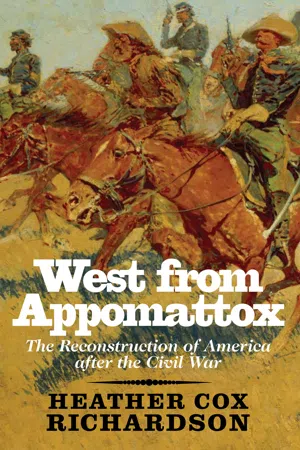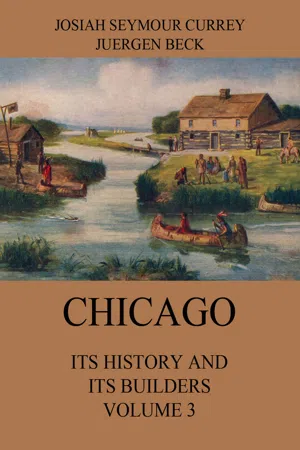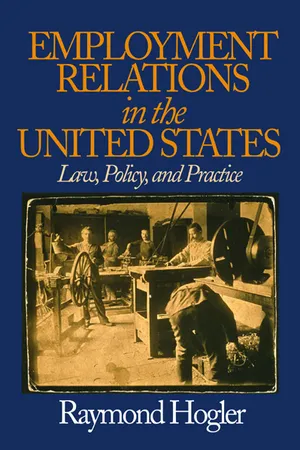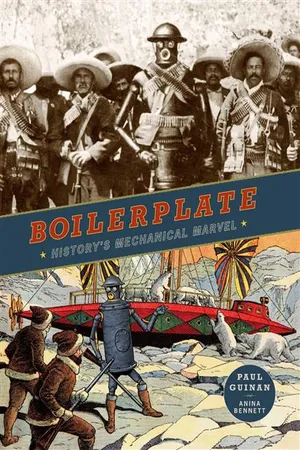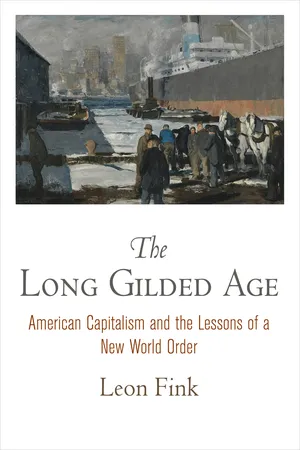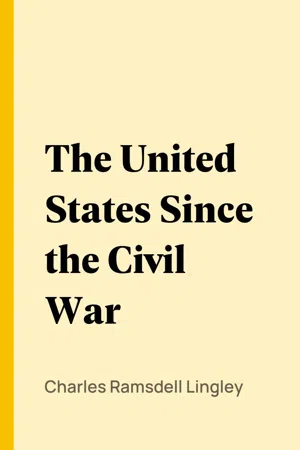History
Pullman Strike of 1894
The Pullman Strike of 1894 was a major labor conflict in the United States that began when the Pullman Company, a railcar manufacturer, reduced wages without lowering rents in its company town. The American Railway Union, led by Eugene V. Debs, organized a boycott of trains carrying Pullman cars, which disrupted rail traffic nationwide. The federal government intervened, leading to a violent confrontation and the eventual suppression of the strike.
Written by Perlego with AI-assistance
Related key terms
10 Key excerpts on "Pullman Strike of 1894"
- eBook - ePub
Turning The Century
Essays In Media And Cultural Studies
- Carol Stabile(Author)
- 2018(Publication Date)
- Routledge(Publisher)
10 Constructions of Violence: Labor, Capital, and Hegemonic Struggle in the Pullman Strike of 1894 KEVIN AYOTTEThe closing decades of the nineteenth century in the United States were anything but peaceful for the working class, or for capitalist industry. Labor conflicts over exploitative working conditions and low wages resulted in a series of strikes across all sectors of the economy. These disputes were the inevitable result of a rapidly expanding capitalist economy that was as yet largely unregulated by the federal or state governments. The repression of labor dissent was realized in a variety of forms, but all represented a struggle on the part of the capitalist ruling class to maintain its economic and political hegemony over American society. On May 11, 1894, the workers at the Pullman Palace Car Company in Chicago, Illinois, left their jobs to protest a reduction in wages and untenable living conditions in the company town of Pullman, Illinois. As long as the strike remained localized at the Pullman Company in Chicago, the federal government, indeed much of the country, took little notice. Then, on June 26, 1894, members of the American Railway Union (ARU) initiated a sympathetic strike by refusing to handle any trains carrying Pullman cars, and eventually the strike halted virtually all railway commerce throughout major sections of the country. In a capitalist nation that depended upon rail transportation for the provision of industrial supplies, foodstuffs, and passenger conveyance, which ultimately produced profit for great numbers of business interests, the nationwide strike represented a challenge to the very ruling order of society.As Antonio Gramsci has explained, one of the scenarios for a true hegemonic crisis may come about “because huge masses … have passed suddenly from a state of political passivity to a certain activity, and put forward demands which taken together, albeit not organically formulated, add up to a revolution. A crisis of authority’ is spoken of: this is precisely the crisis of hegemony, or general crisis of the State.”1 - eBook - ePub
Labor in America
A History
- Melvyn Dubofsky, Joseph A. McCartin(Authors)
- 2017(Publication Date)
- Wiley-Blackwell(Publisher)
There were a number of other violent strikes during the turbulent 1890s, especially during the depression years as corporate leaders rode roughshod over the right of their workers to organize in defense of their interests. Metal miners in the Cripple Creek district of Colorado and Coeur d'Alene, Idaho, railroad switchmen in Buffalo, New York, and coal miners in Tennessee walked out in defiance of their employers, and in each instance violence erupted that brought the intervention of the state militia, whose commanders assisted employers in breaking up strikes and union power. As depression settled ominously over the land and the army of the unemployed swelled to some 3 million, labor disputes reached a peak involving some 750,000 workers – more than had participated during the strikes in 1886. Among all these conflicts, the Pullman Strike of 1894 stood out most vividly.In one respect, the employees of the Pullman Palace Car Company were in quite a different situation from that of most industrial workers. The workers who built the ubiquitous sleeping cars that were attached to most of the nation's trains lived in a company town just outside Chicago. In 1881, the head of the company, George M. Pullman, had established for his employees Pullman, Illinois, a community with neat brick houses grouped about a little square, where bright flowerbeds alternated with green stretches of lawn. The whole was “shaded with trees, dotted with parks, and pretty water vistas and glimpses here and there of artistic sweeps of landscape gardening.” In the exuberant enthusiasm of the company's press agent, Pullman was “a town, in a word, where all that is ugly and discordant and demoralizing is eliminated and all that which inspires self-respect is generously provided.”But were these happy attributes of life in Pullman actually so “generously provided?” The employees had little choice but to live within this feudal domain, rent their homes or apartments from the company, buy their water and gas from the company, pay the company for such other services as garbage removal and the daily watering of streets, buy supplies from the company store, and subscribe to the company's rental library. And in the model town, rents for apartments, which in most instances had no bathtub and but one water faucet for every five families, were some 25 percent higher than in nearby communities. A high premium was also charged for public utility services. “Oh, Hell!” the forthright Mark Hanna was quoted as commenting on his brother industrialist's baronial domain. “Go and live in Pullman and find out how much Pullman gets selling city water and gas 10 per cent higher to those poor fools!” - eBook - ePub
The Essential Mike Davis
Politics and Economy in the History of the US Working Class
- Mike Davis(Author)
- 2018(Publication Date)
- Verso(Publisher)
The fighting will and consciousness of a whole generation of labor militants, matured over the long cycle of struggles and movements since 1877, were tested in the series of violent battles that culminated in the American Railroad Union’s boycott of the Pullman Company in 1894. What was so remarkable about the Pullman strike, distinguishing it among the three or four most climactic labor battles in American history, was not only its escalation into a national confrontation between hundreds of thousands of workers and the federal government—this had also occurred in 1877—but, rather, its unprecedented conjunction with massive upsurges of native agrarian radicalism and international labor politics. 44 The birth of the Farmers’ Alliance in the late eighties, in a period of falling crop prices and rising rents, had signalled a radicalization of agrarian protest in the United States. Whereas previous farmer movements, such as the various ‘farmer parties’ of the 1870s or the national Grange, had tended to represent the interests of more prosperous farmers, the Alliance derived an almost millenarian energy from its roots in the poorer strata of the rural population. Especially in the Southern cotton belt where the ancien régime had been recast into the debt servitude of the crop-lien system, the Alliance, by its unprecedented feat of uniting Black and white tenants, had become a subversive force of unknown potential. Furthermore, in areas of the South and the Southwest, an active cooperation existed between trade unions, local assemblies of the Knights and the Alliance. (A frequently overlooked fact was the dynamism of Southern trade unionism in the late eighties - eBook - ePub
West from Appomattox
The Reconstruction of America after the Civil War
- Heather Cox Richardson(Author)
- 2007(Publication Date)
- Yale University Press(Publisher)
Workers resented Pullman’s interference in their lives. “The corporation is everything and everywhere,” wrote a reporter for the Pittsburgh Times, “the corporation does everything but sweep your room and make your bed, and the corporation expects you to enjoy it and hold your tongue.’’ Asserting their independence, many workers aspired to leave the town, even if it meant moving to slums outside it. This conflict was latent while the economy was strong, but it came to the surface when Pullman cut wages five times in 1894 without reducing the high rents for company houses, while leaving officers’ salaries intact and with Pullman stock selling above par. Workers at the Pullman Palace Car Company struck. 23 The Pullman strike rapidly became a national concern. The American Railway Union (ARU), led by Eugene Debs, had formed the year before to oppose the General Managers’ Association of the twenty-four railroads in the Chicago area, an employers’ organization that made sure wages were kept even across the lines. The ARU’s 150,000 members supported the Pullman strikers and refused to handle trains that used Pullman cars. Transportation ground to a halt around the country, “paralyzing nearly every railroad west of Ohio,” according to one observer. Although most Pullman workers simply wanted to make enough to live on, their cause was popularly associated with radicals who saw the recent strikes as the sign of an approaching showdown between labor and capital. It was time, announced the Central Labor Federation, for every worker to “cast his ballot for the overthrow of the capitalistic system that is now being bolstered up by the power of arms by the President of the United States, in whom the greedy, grasping monopolies trust, and in whom they have found a willing protector in his capacity of Commander in Chief of the army and navy.’’ When a terrible fire burned the vacant White City on July 5, many Americans blamed the strikers and saw anarchism attacking American progress - eBook - ePub
- Josiah Seymour Currey(Author)
- 2017(Publication Date)
- Jazzybee Verlag(Publisher)
THE COMMENCEMENT OF THE STRIKEIt will be seen that the employees of the Pullman Company had no part in the American Railway Union, and although local unions had been formed among them during the previous winter and spring they did not join in the great combination of labor unions we have just referred to. The previous year, the year of the World's Fair, was marked by a severe financial panic which affected all industries. During the following fall and winter the Company reduced its force to about two thirds of its previous numbers, and at the same time reduced wages from thirty to fifty per cent. "The result was," says Bancroft, "that the wages earned in the lower grades of service were hardly sufficient to provide the ordinary necessities of life. The irritation caused by the reductions was much aggravated by the fact that the company was also the landlord of the majority of the workmen, and that it made no reduction in rents.... It was, therefore, both natural and reasonable that the employees should be dissatisfied and restless under the conditions existing in the spring of 1894."On the 11th of May a strike among the Pullman employees began, and for the following seven weeks there was no disorder among the strikers. "The universal comment," says Carwardine, "was complimentary to the decorum of the strikers." As time elapsed the company made no effort to resume work. "The strike had become a lockout; the strikers seemingly were worsted. In the meantime the officers of the American Railway Union investigated conditions at Pullman, and decided that the strikers ought to be sustained with the full strength of the union."At a convention of the governing body of the American Railway Union, held on the 12th of June, President Debs in his opening address said that the Union was the first of the railway organizations that was properly constructed; that all others "had blow-holes in their armor while this one was built for war, and no weakness would be found in it when it came time to test its armament." The convention declared in favor of taking up the fight against the Pullman Company. A committee was appointed to wait upon the manager who, however, refused to recognize them or treat with them. On June 22, the delegates, having been so instructed by their respective unions, voted that if the Pullman Company did not adjust its differences with its employees by noon of June 26, a boycott would then be enforced against the hauling of its cars. - eBook - ePub
Employment Relations in the United States
Law, Policy, and Practice
- Raymond L. (Louis) Hogler(Author)
- 2003(Publication Date)
- SAGE Publications, Inc(Publisher)
54 Not until after World War I did unionism present a serious threat to the steel industry, when it was once again defeated.Pullman and the Railway Strike, 1894
The U.S. economy entered another period of recession in 1893. This downturn was particularly severe, resulting in business failures and massive unemployment. Throughout the country, employers responded with wage cuts and other measures designed to cut production costs. Among workers so affected were those at the Pullman Company outside Chicago.The Pullman Palace Car Company built elaborate sleeping cars for travel on the railroads. Founded by George Pullman in 1867, the company quickly eliminated any serious competition and serviced more than three-fourths of the U.S. railway mileage by 1894.55 Pullman himself was widely regarded as a progressive, innovate employer. He built the town of Pullman to rent housing to his employees, and in many respects, it was a model community. It had excellent sanitary facilities, schools, and a public library, and city officials discouraged drinking and prostitution. Underneath the facade, however, life in Pullman was not ideal. Pullman expected his town to show a profit, and he charged prices for gas, water, and rent that were substantially higher than prices in surrounding communities. Moreover, the company followed the practice of issuing two checks to its workers, one for the amount of wages, and one for the amount of rent; the employee endorsed the rent check and promptly handed it back to the paymaster. Pullman also tried to control the political views of the town’s inhabitants, instructing them on correct choices in local and national elections. Pullman’s employees gradually came to resent his extreme paternalism.The immediate origin of the strike was Pullman’s order to reduce wages. The depression of 1893 substantially reduced Pullman’s contracts for car construction, and he met competitive pressures by bidding at prices below the cost of building cars. To minimize his losses, Pullman cut workers’ wages. Despite the wage reductions, Pullman refused to lower his rents, asserting that the rental business and the car construction business were separate. As a consequence, employees often had little income remaining after their rent payments. One skilled mechanic, for example, received a check for $9.07 for two weeks’ work, but the company took $9.00 for rent. - eBook - ePub
Boilerplate
History's Mechanical Marvel
- (Author)
- 2012(Publication Date)
- Abrams Image(Publisher)
Boilerplate pulls one ofPullman’s famous sleeper cars, the ultimate in luxury and high-techrail transportation of the day, at the Chicago World’s ColumbianExposition in 1893.drew Boilerplate more deeply into the Pullman story began with the financial Panic of 1893 and the depression that ensued. When George’s business fell off, he laid off workers and cut wages—without reducing rents or water charges. Rent was deducted from paychecks, leaving many Pullman employees without enough money to buy food. Some were forced into perpetual debt to the company. Company stockholders still received their guaranteed 8 percent profit, though.A residential street in Pullman. Its seemingly idyllic appearancedoes not betray the oppressiveaspects of a company town. Today, Pullman is a neighborhood on thesouth side of Chicago. 34 CHAPTER 3Archie Campion’s sister, Lily, stayed at the world-class HotelFlorence, named after GeorgePullman’s daughter, during a tourof Pullman town. Lily supportedthe railroad tycoon’s stated intentto raise the quality of life amonglaborers, but she recognized thatPullman’s company town was farfrom a utopian dream—it was, infact, an economic prison for manyworkers.Passage contains an image Plans for a typical two-story four-flatthat housed workers in Pullmantown. The living room was 11 x 14’, with 7 x 13’ and 6 x 10’ bedrooms. The National Guard was among the armed forces sent to Chicago to protect railroads during thePullman strike. STRIKE!
By May 1894, Pullman workers had reached the breaking point. George refused to negotiate or offer any relief, so they voted to strike. In June they won support from the American Railway Union (ARU), a national organization headed by former railroad fireman Eugene Debs. Within weeks, the nation’s railroads were all but paralyzed. The cost of groceries and other goods soared in Chicago.What began as a peaceful, organized strike for better wages turned nasty after President Grover Cleveland ordered the U.S. Army into Chicago on July 3, despite Illinois Governor John Altgeld’s strong objections. It was an unprecedented move. Archie paid scant attention to these events until July 5, when an unexplained fire burned down seven buildings on the Columbian Exposition grounds—including Machinery Hall, the site of Boilerplate’s public debut. Although the fire’s cause was never conclusively proven, inflammatory newspaper accounts blamed striking Pullman workers. - eBook - ePub
The Long Gilded Age
American Capitalism and the Lessons of a New World Order
- Leon Fink(Author)
- 2014(Publication Date)
- University of Pennsylvania Press(Publisher)
The crushing of the strike and imprisonment of Debs put the industrialist and key political supporters in a bad public light. The resulting strike commission authorized by a pressured President Cleveland proved caustic in its assessment of the paternalistic treatment of the workers at Pullman and effectively spanked the industry by calling for an impartial railroad commission, trade union recognition, and even compulsory arbitration in the settlement of future disputes. 52 The boycott and strike also left the whole concept of the company town with a bad name. By 1894, the state’s supreme court stripped the Pullman Company of its ownership rights over town property, ending the vision with which it was conceived. Pullman himself died of a heart attack in 1897, never regaining his public stature, and seeking eternal shelter from potential depredations of ex-Pullman rioters in one of the most secure tombs ever constructed. 53 The law-and-order forces at Pullman include at least two other figures who superficially fit the mold of corporate lackeys. Both General Nelson Miles and Attorney General Olney played important coercive roles in relation to the striking workers. As western field commander of the U.S. army, Miles had helped subdue Chief Joseph and Geronimo before closing in on the Sioux and securing Sitting Bull’s arrest in 1890. By outward measure, his supervision, as major general, regular army of the federal government’s occupying forces in the Chicago region seems the perfect embodiment of what Richard Slotkin described as the transfer of the “myth of the frontier” onto the industrial landscape. 54 On more than one occasion, however, Miles’s very military professionalism also raised a cautionary flag in the use of unbridled force. Even as an Indian-fighter, he proved something of a moderate - eBook - ePub
The Selected Works of Eugene V. Debs Volume II
The Rise and Fall of the American Railway Union, 1892–1896
- Tim Davenport, David Walters(Authors)
- 2020(Publication Date)
- Haymarket Books(Publisher)
Since that period of vanquishing wrong and the enthronement of the right, a system of wage-slavery has been introduced. Warmed into life in the womb of greed, and fostered by laws and legislation as unholy as that which legalized slave stealing and the breeding of human beings like swine for the market, it has gained power and prestige until wage-slaves, under the domination of the money power, acting through trusts, syndicates, corporations, and monopoly-land stealing, capitalization, railroad wrecking, bribery, and corruption, defying proper characterization, we are confronted with conditions bearing the impress of peonism, infinitely more alarming than was African slavery in its darkest days.Under such circumstances, what, I ask, is more natural within the entire realm of human duties than that wage-men should organize, agitate, and strike for their rights?The Pullman strike, confessedly more far-reaching in its sweep and significance than any other struggle the continent has witnessed, will pass into history as having been the one thing needful to arouse the nation to the perils which the money power has spawned upon the country.The American Railway Union, having from the first discountenanced violence and deplored the destruction of property, may, I think, suggest that the Pullman strike, notwithstanding such unfortunate features, has its compensations. No one will deny that the Pullman strike has aroused the government from its stupor to a sense of its obligations to ascertain the cause of the phenomenal disturbance, and the work of investigation, once begun, the hope and the belief may be entertained that it will be prosecuted until foundation infamies are discovered and dragged forth for the enlightenment of those who, in the absence of such information, find it profitable to apply the epithet of “anarchist” to those whose courage created the necessity for investigation, which, if honest and thorough, as indications warrant, the inevitable conclusion will be reached that men who strike against starvation wages and for the protection of those who are dependent upon them against corporate and plutocratic spoliation represent the true American spirit and courage which, once destroyed by the rapacity of heartless employers of the Pullman stripe, aided by United States courts and United States troops, would foreshadow calamities which it would be difficult to exaggerate. If, through the agencies of investigation and legislation, the curse of wage-slavery disappears, or is so modified as to produce greater contentment in the armies of labor, fruitful of the hope that at no distant day full emancipation shall be secured by wise legislation, the American Railway Union will expand to colossal proportions of organized philanthropy such as the ages have not witnessed, because the lesson it will have taught legislators and courts, presidents and governors, and men in command of military machines is that the majesty of truth and justice, rather than the tyranny of injunctions, aided by the persuasive power of powder, must preserve our free institutions if they are to be perpetuated. Never since the colonies were rescued from the grasp of King George has man’s capacity for self-government been so confessedly on trial as in these closing years of the century. Thoughtful Americans are adopting the views expressed by Lord Macaulay,7 - eBook - ePub
- Charles Ramsdell Lingley(Author)
- 2006(Publication Date)
- Perlego(Publisher)
During the four decades between the opening of the Civil War and the close of the nineteenth century, the United States became in many respects an economic unit. The passage of the Interstate Commerce Act in 1887, for instance, was an early recognition of the fact that the transportation problem of the nation transcended state bounds; the Sherman Anti-trust law of 1890 arose from the realization that commercial and industrial unity were rapidly coming to pass; the American Federation of Labor brought workmen from all states and many trades into a single organization. The election of 1896 and the amazing consolidation of business enterprises at the close of the century were further proofs that the day had passed when any section of the United States could live an isolated economic life without relation to other parts of the country. Instead of remaining a federation of diverse economic sections, we became increasingly homogeneous. Much of the economic and political legislation enacted after 1896, and many of the practices and standards which were adopted by leaders in economic and political life were an outgrowth of the new conditions.It will be remembered that the eighties and early nineties had been years of labor unrest. Costly and bitter strikes on the part of the workmen, and resolute and powerful resistance on the part of the employers were the commonplaces of the history of labor. The culmination was the Pullman Strike of 1894.[1] Its cost in money and suffering was appalling; it placed the federal military power in the hands of the employers; and although it was a failure as far as the strikers were concerned, yet an impartial investigation after the struggle was over established the justice of much of which the men had complained. If discriminating justice were to be measured out to both sides, instead of victory to the side of the strongest battalions, and if intolerable waste and discomfort were to be avoided, some remedies for industrial unrest must be discovered which would replace strikes and violence. Happily, signs were not wanting that such a change was slowly taking place.
Index pages curate the most relevant extracts from our library of academic textbooks. They’ve been created using an in-house natural language model (NLM), each adding context and meaning to key research topics.
